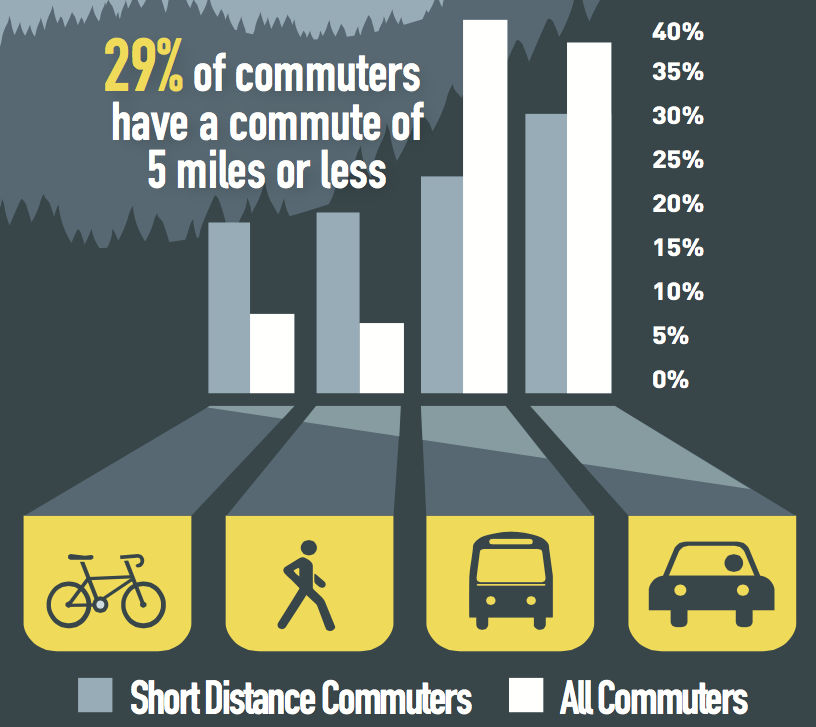Downtown Commuter Survey Reveals the Weakness of Denver Transit

The Downtown Denver Partnership last week released the results of its commuter survey, an annual exploration of how people get to and from their workplaces downtown. DDP polled 5,740 commuters, which is almost 5 percent of all downtown workers.
A plurality of people polled, about 41 percent, said they commute via transit. That’s less than the 44 percent share in 2013. Almost as many people, about 39 percent, said they drive solo to work.

Compare those figures with Seattle, where 45 percent of people take transit, and just 31 percent of people commute downtown by driving alone.
People who walk to work in downtown Denver account for 5.6 percent of responses. The share of people biking is 6.5 percent, unchanged since last year but up 2 percent since 2013. (Seattle’s bike riders only account for 3 percent of downtown commuters.)
So what does it all mean? Streetsblog Denver analyzed the numbers and spoke with DDP’s Director of Downtown Environment Aylene McCallum to glean what some of the figures say about the choices people are making, and why they make them.
Driving Alone Is More Attractive Than Taking Transit for Commuters Who Live in Denver
People who live within five miles of downtown are more likely to drive than use RTD’s bus or rail service. The further people live from downtown, the more likely they are to take transit. These stats make sense when you account for the investments in regional rail and bus service over the last decade through the voter-approved FasTracks expansion.

What makes transit so unattractive, even when riders only need to go a short distance? Maybe it’s the infrequent service on many bus routes. Maybe it’s the cumbersome, outdated fare technology that makes buying tickets and boarding a hassle. Maybe it’s because RTD can’t relay arrival and departure information in real time.
“There hasn’t been a huge focus by RTD on improving local services, because they’ve been working on FasTracks,” McCallum says. “If you look at what RTD is doing in the next couple of years, it is almost entirely focused outside of the city of Denver.
“The city is taking a leadership role in 2016 in doing this transit study. How can the study work better with RTD to improve transit within the city of Denver? I think given this [survey] information, this is absolutely the right direction for this to be headed.”
Biking and Walking Is Also More Attractive Than Transit for Close Commuters
People who live within five miles of downtown are three times more likely to bike and 3.5 times more likely to walk to work than the general population, according to the survey. The significant increase in walking probably goes hand in hand with the fast-rising walkable developments in and around the downtown core. The share of bike commuters dropped .01 percent — a number that DDP President and CEO Tami Door guaranteed would change with the proliferation of more protected bike lanes like those on Arapahoe and Lawrence.
“What I’m surmising is that a lot of those folks that would be taking transit — and some that would be driving alone — are using biking and walking to get to work,” McCallum said. “Meaning that for whatever reason, RTD services for within that five-mile radius of downtown Denver are not as competitive with biking, walking, and driving alone.”
A Huge Parking Supply Probably Disincentivizes Car-Free Transportation Options
If you extrapolate the numbers from the latest commuter survey, about 46,500 workers drive in and out of downtown daily. The downtown area has about 45,000 public parking spaces between garages and on-street spaces, according to DDP’s parking inventory, which doesn’t include any private lots and garages.
“Absolutely there are far more parking spaces than car commuters,” McCallum says. “Think about the parking lots at the Auraria Campus and new developments around Union Station. That’s a really good example of where people are parking who you’re including in that driving alone group.”
DDP’s main prerogative is economic development, and McCallum says a lot of money being spent to drive and park downtown could do more for the local economy if it were spent on other services and goods. Conservatively, car commuters are spending tens of millions of dollars each year to store their vehicles downtown.
“I think no matter what numbers you use, if you want to take the most conservative numbers, on an annual basis, downtown Denver commuters driving alone are spending a huge amount of money on parking and driving to work,” McCaullum says. “And I think the question I’m asking is, how will that money benefit our local economy if even just a portion of those funds were redirected to local restaurants or local retailers within the city? It would be a huge injection into our local economy to support retail and the vibrancy of downtown Denver because they wouldn’t be spending their money in their commute, they’d be investing it in the local environment.”


